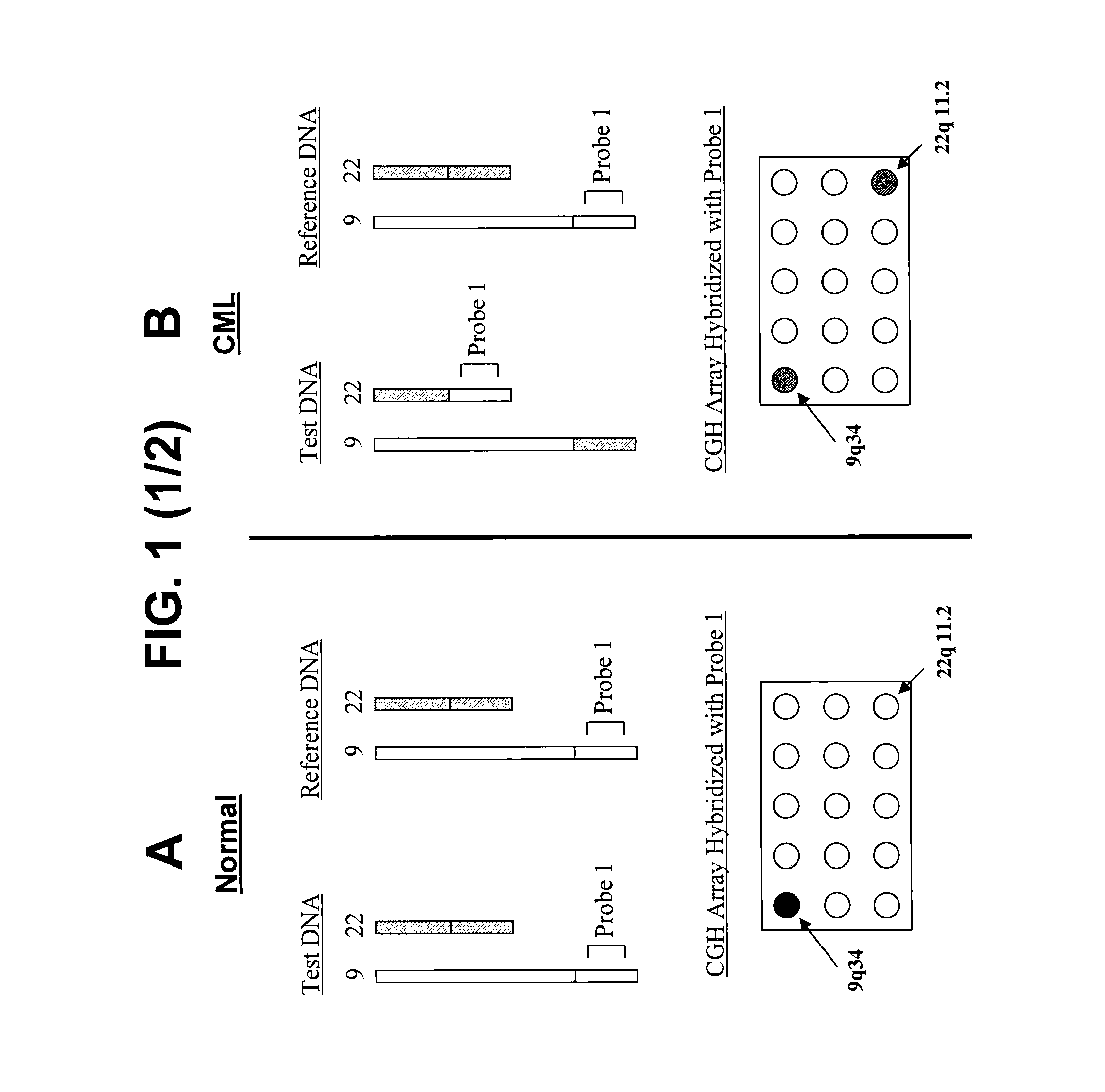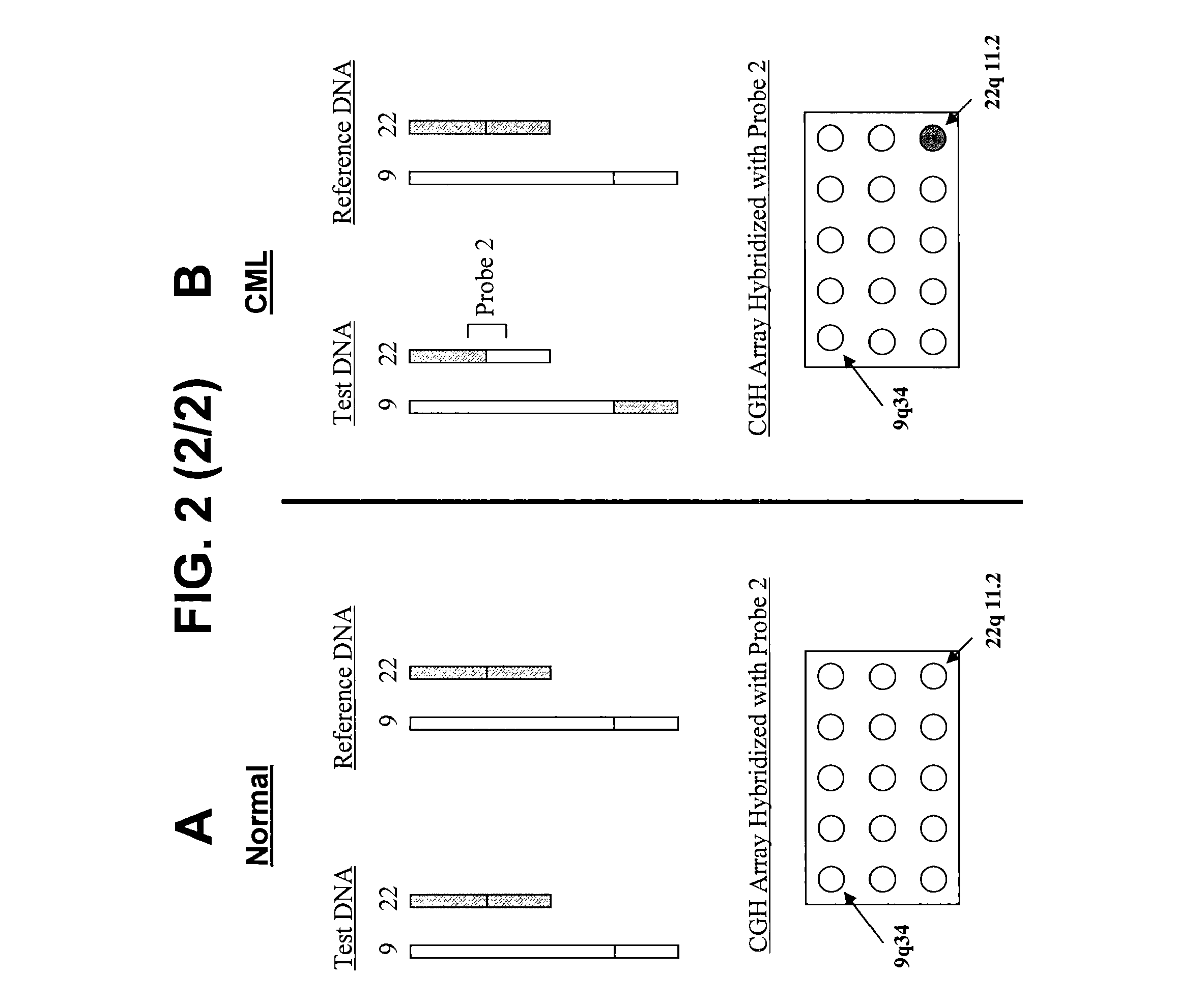Balanced translocation in comparative hybridization
a chromosomal translocation and comparative hybridization technology, applied in the field of chromosomal abnormalities detection methods, can solve the problems of mental retardation, translocations with more severe phenotypic consequences, and cgh has not been used to detect balanced chromosomal translocations, and achieve the effect of a more informative method and a shorter time fram
- Summary
- Abstract
- Description
- Claims
- Application Information
AI Technical Summary
Benefits of technology
Problems solved by technology
Method used
Image
Examples
example 1
Preparation of a Genomic Nucleic Acid Array
[0202]A variety of microarray equipment (e.g., BioRobotics Microgrid and others; collectively “arrayers”) are available for printing genomic nucleic acid material onto a plurality of discrete locations of a solid surface. Two specific surfaces were printed with native BAC DNA to establish a protocol for the specific application of large-insert clone microarray fabrication (e.g., BACs, PACs, cosmids).
[0203]Typical prior art arrayer installation and validation protocols assess the printing performance of an arrayer using either dye-only solutions or dye-oligo DNA solutions. These conditions do not reflect the fluid dynamics associated with large clone array manufacturing and hence are sub-optimal for generating printing parameters. The present example described herein establishes a simple and qualitative approach to validating arrayers and establishing printing parameters for large insert clone microarray fabrication.
[0204]A sample collection...
example 2
Preparation of Genomic Nucleic Acids
[0206]Labeling. Genomic DNA may be labeled by any standard protocol to incorporate a detectable label. An exemplary random priming with a fluorophore is as follows. In a 100 μl reaction containing 1 ng to 1 μg DNA, combine 1× random primers solution (BioPrime DNA Labeling System, Gibco BRL), 1 mM Tris, pH 7.6, 0.1 mM EDTA, 0.2 mM each of dATP, dTTP and dGTP, 0.1 mM dCTP, 0.4 mM Cy3 or Cy5-dCTP (Amersham) and 160 U Klenow fragment (BioPrime DNA Labeling System, Gibco BRL). The DNA and random primers solution is incubated at 100° C. for 10 minutes in a total volume of 84 μl, prior to adding the other reagents, and then the final 100 μl reaction is incubated overnight at 37° C. Unincorporated nucleotides are removed using a Sephadex G-50 column.
[0207]Dendrimeric labeling. Genomic DNA may contain a tag contained within a dendrimeric construct. A dendrimer is a highly branched molecule created to integrate multiple copies of the desired detectable labe...
example 3
[0209]Comparative Genomic Hybridization
[0210]Genomic nucleic acids obtained from a test sample and a reference sample, each population containing a unique capture sequence, are combined (about 1-2 μg each) with Cot-1 DNA (80-100 μg) and precipitated with ethanol. Precipitate is collected by centrifugation and allowed to air dry for 10 minutes before re-dissolving it in a 50 μl hybridization mixture containing 50% formamide, 2×SSC, 10% dextran sulfate, 4% SDS and 500 μg yeast tRNA, pH 7. The hybridization mixture is incubated at 70° C. for 10-15 minutes to denature the DNA and subsequently at 37° C. for 60 minutes to allow blocking of repetitive sequences. To the array is added 50 μl of slide blocking solution containing 500 μg salmon sperm DNA in 50% formamide, 2×SSC, 10% dextran sulfate and 4% SDS, pH 7. After a 30 minute incubation at room temperature, approximately three-quarters of the blocking solution is removed, and the denatured and re-annealed hybridization mixture is added...
PUM
| Property | Measurement | Unit |
|---|---|---|
| diameter | aaaaa | aaaaa |
| areas | aaaaa | aaaaa |
| concentration | aaaaa | aaaaa |
Abstract
Description
Claims
Application Information
 Login to View More
Login to View More - R&D
- Intellectual Property
- Life Sciences
- Materials
- Tech Scout
- Unparalleled Data Quality
- Higher Quality Content
- 60% Fewer Hallucinations
Browse by: Latest US Patents, China's latest patents, Technical Efficacy Thesaurus, Application Domain, Technology Topic, Popular Technical Reports.
© 2025 PatSnap. All rights reserved.Legal|Privacy policy|Modern Slavery Act Transparency Statement|Sitemap|About US| Contact US: help@patsnap.com


